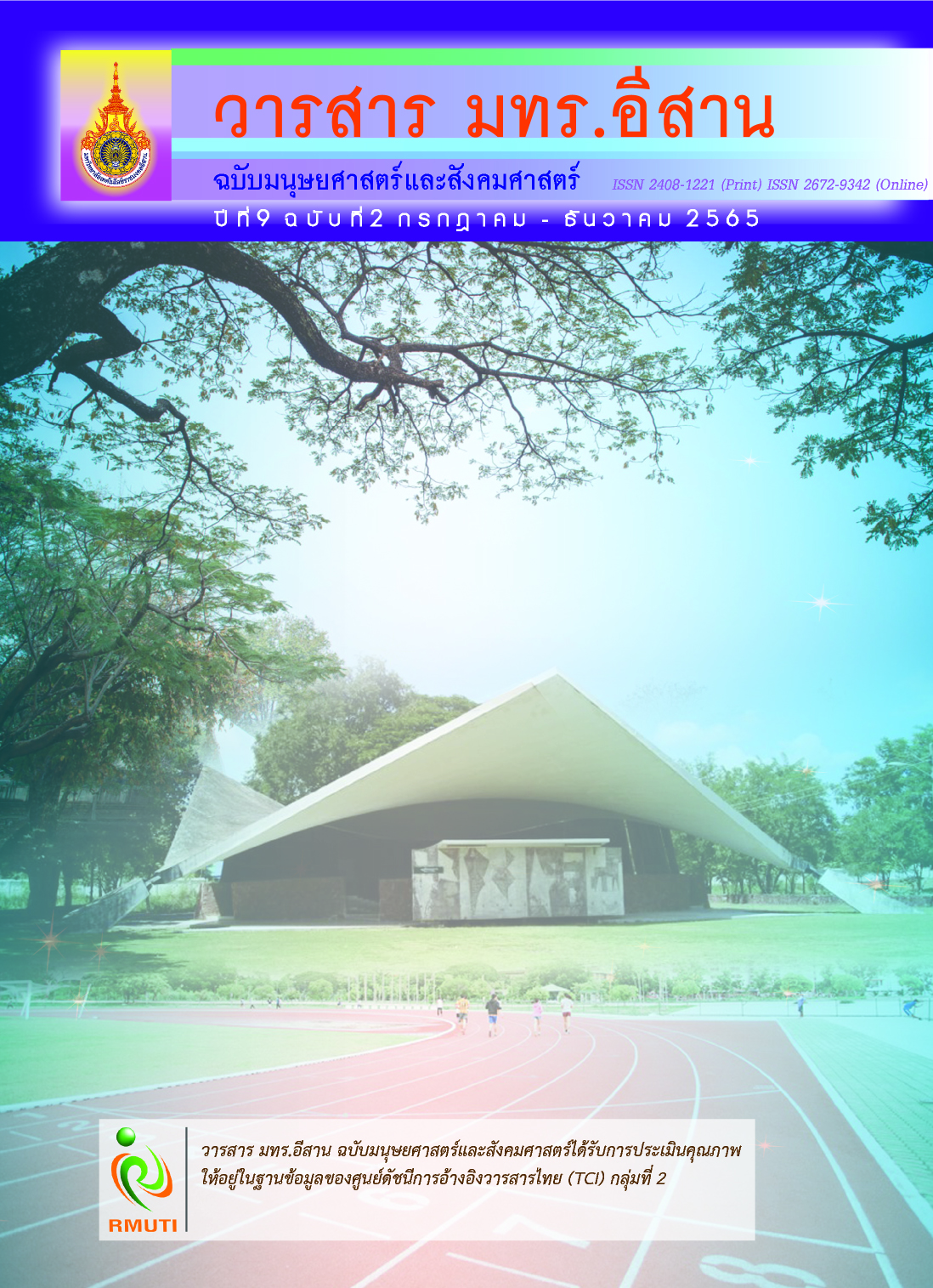The Role of Acceptance and Use of Technology in Online Purchase Decisions of People Entering the Aging Society
Main Article Content
Abstract
This research paper presents the role of acceptance and use of technology in online purchase decisions of people who are entering the aging society in Muang District, Nakhon Ratchasima. Questionnaires were reviewed by the Human Research Ethics Committee, Rajamangala University of Technology Isan prior to being used as data collection tools from 288 people. Purposive sampling was used with quantitative research where multiple regression statistics was used for data analysis. The results showed that the acceptance and use of information technology affected purchasing decisions. The key factors influencing users’ purchasing decisions were attitude toward using (effect size = 0.329), perceived usefulness (effect size = 0.228), and intention to use (effect size = 0.166). Therefore, information technology acceptance and social changes in consumption were factors that contributed to the increase in online shopping, which enabled human behavior to express or react when confronted with a variety of stimuli or situations influenced by perception and accessibility of technology on various electronic devices. The perception and comprehension of facts, news and information of the people resulted in learning, adaptation, and continuous use of technology. This has become a habit of using information and communication technology which directly influences decision on buying products via online media or other decisions in daily life of those who are entering the aging society.
Article Details

This work is licensed under a Creative Commons Attribution-NonCommercial-NoDerivatives 4.0 International License.
บทความที่ได้รับการตีพิมพ์เป็นลิขสิทธิ์ของมหาวิทยาลัยเทคโนโลยีราชมงคลอีสาน
ข้อความที่ปรากฏในบทความแต่ละเรื่องในวารสารวิชาการเล่มนี้เป็นความคิดเห็นส่วนตัวของผู้เขียนแต่ละท่านไม่เกี่ยวข้องกับมหาวิทยาลัยเทคโนโลยีราชมงคลอีสานและคณาจารย์ท่านอื่นๆในมหาวิทยาลัยฯ แต่อย่างใด ความรับผิดชอบองค์ประกอบทั้งหมดของบทความแต่ละเรื่องเป็นของผู้เขียนแต่ละท่าน หากมีความผิดพลาดใดๆ ผู้เขียนแต่ละท่านจะรับผิดชอบบทความของตนเองแต่ผู้เดียว
References
กรมกิจการผู้สูงอายุ. (2564). สถิติผู้สูงอายุ. เข้าถึงเมื่อ (7 พฤษภาคม 2565). เข้าถึงได้จาก (https://www.dop.go.th/)
กัลยา วานิชย์บัญชา และฐิตา วานิชย์บัญชา. (2561). การใช้ SPSS for Windows ในการวิเคราะห์ข้อมูล. (พิมพ์ครั้งที่ 31). กรุงเทพฯ: สามลดา
พูนเพิ่ม เสรีวิชยสวัสดิ์. (2562). การพัฒนารูปแบบการยอมรับการใช้เทคโนโลยีของพนักงานในอุตสาหกรรมไมซ์ในประเทศไทย. วิทยานิพนธ์ปรัชญาดุษฎีบัณฑิต มหาวิทยาลัยศิลปากร
ศิริลักษณ์ โรจนกิจอำนวย. (2561). การรับรู้ความเสี่ยงและความไว้วางใจที่ส่งผลต่อการซื้อผ่านพาณิชย์อิเล็กทรอนิกส์ข้ามพรมแดน. จุฬาลงกรณ์ธุรกิจปริทัศน์. ปีที่ 40, ฉบับที่ 157, หน้า 79-99
สารัช สุธาทิพย์กุล และพิทักษ์ ศิริวงศ์. (2560). สภาพปัญหา และการเรียนรู้การใช้เทคโนโลยีของผู้สูงอายุกรณีศึกษา ผู้สูงอายุที่ใช้สมาร์ทโฟนในพื้นที่บริเวณโดยรอบพระปิ่นเกล้า เขตบางกอกน้อย จังหวัด
กรุงเทพมหานคร. เข้าถึงเมื่อ (7 พฤษภาคม 2565). เข้าถึงได้จาก (https://repository.rmutr.ac.th/bitstream/handle/123456789/760/rmutrconth_114.pdf?sequence=1&isAllowed=y)
สำนักงานพัฒนาธุรกรรมทางอิเล็กทรอนิกส์. (2564). รายงานผลการสำรวจพฤติกรรมผู้ใช้อินเทอร์เน็ตในประเทศไทย ปี 2564. เข้าถึงเมื่อ (7 พฤษภาคม 2565). เข้าถึงได้จาก (https://www.thaipdf.com/2151-thailand-internet-user-behavior-2021/)
สำนักงานสถิติแหง่ ชาติ. (2564). สำรวจการมีการใช้เทคโนโลยีสารสนเทศและการสื่อสารในครัวเรือน พ.ศ. 2563. เข้าถึงเมื่อ (1 ตุลาคม 2565). เข้าถึงได้จาก (http://www.nso.go.th)
สำนักบริหารการทะเบียน กรมการปกครอง. (2565). สถิติประชากรรายจังหวัด. เข้าถึงเมื่อ (7 ตุลาคม 2563). เข้าถึงได้จาก (https://stat.bora.dopa.go.th/StatMIS/#/ReportStat/1)
สุทธยา สมสุข. (2562). พฤติกรรมการใช้สื่อสังคมออนไลน์ของผู้สูงอายุ. วารสารปาริชาต มหาวิทยาลัยทักษิณ. ปีที่ 33, ฉบับที่ 1, หน้า 62-77
สุธาสินี ตุลานนท์ และวศิน เหลี่ยมปรีชา. (2562). การยอมรับเทคโนโลยีที่มีผลต่อการตัดสินใจซื้อสินค้าออนไลน์ของผู้สูงอายุ. วิทยานิพนธ์ปริญญาบริหารธุรกิจมหาบัณฑิต มหาวิทยาลัยนเรศวร
สุวิช ถิระโคตร และวีรพงษ์ พลนิกรกิจ. (2561). พฤติกรรมการใช้และการรู้เท่าทันอินเทอร์เน็ตและทัศคติการใช้เนื้อหาด้านสุขภาวะบนอินเทอร์เน็ตของผู้สูงอายุ. วารสารการพยาบาลและการดูแลสุขภาพ. ปีที่ 36, ฉบับที่ 1, หน้า 72-80
อัครพงศ์ อั้นทอง. (2550). คู่มือการใช้โปรแกรม EViews เบื้องต้น สำหรับการวิเคราะห์ทางเศรษฐมิติ. เข้าถึงเมื่อ (7 พฤษภาคม 2565). เข้าถึงได้จาก (https://piboonrungroj.files.wordpress.com/2011/08/akarapong_handbook_eviews_basic_econometrics.pdf)
อารยา ผลธัญญา. (2564). การใช้เครือข่ายสังคมออนไลน์กับการส่งเสริมคุณภาพชีวิตของผู้สูงอายุ. วารสารบัณฑิตศึกษา มหาวิทยาลัยราชภัฏวไลยอลงกรณ์ ในพระบรมราชูปถัมภ์. ปีที่ 15, ฉบับที่ 3, หน้า 272-288
Adamides, G., Stylianou, A., Kosmas, P. C., and Apostolopoulos, C. D. (2013). Factors Affecting PC and Internet Usage by the Rural Population of Cyprus. Agricultural Economics Review. Vol. 14, No. 1, pp. 1-21. DOI: 10.22004/ag.econ.253535
Aggelidis, V. P. and Chatzoglou, P. D. (2016). Using Modified Technology Acceptance Model in Hospitals. International Journal of Medical Informatics. Vol. 78, Issue 2, pp. 115-126. DOI: 10.1016/j.ijmedinf.2008.06.006
Camarero, C., Antón, C., and Rodríguez, J. (2013). Technological and Ethical Actecedents of E-Book Piracy and Price Acceptance: Evidence from the Spanish Case. The Electronic Library. Vol. 32, Issue 4, pp. 542-566. DOI: 10.1108/EL-11-2012-0149
Chu, A. Z. C. and Chu, R. J. C. (2011). The Intranet’s Role in Newcomer Socialization in Hotel Industry in Taiwan-Technology Acceptance Model Analysis. The International Journal of Human Resource Management. Vol. 22, Issue 5, pp. 1163-1179. DOI: 10.1080/09585192.2011.556795
Davis, F. and Venkatesh, V. (1996). A Critical Assessment of Potential Measurement Biases in the Technology Acceptance Model: Three Experiments. International Journal of Human-Computer Studies. Vol. 45, pp. 19-45. DOI: 10.1006/ijhc.1996.0040
Hair, J. F., Black, W. C., Babin, B. J., and Anderson, R. E. (2010). Multivariate Data Analysis: A Global Perspective. (7th ed.). New Jersey: Pearson Education Inc
Kline, R. B. (2011). Principles and Practice of Structural Equation Modeling. Guilford Press, New York
Kotler, P. and Armstrong, G. (2011). Principles of Marketing. (14th ed.). Pearson Education
Kotler, P., Kartajaya, H., and Setiawan, I. (2017). Marketing 4.0. United States: John Wiley & Sons Inc
Loipha, S. (2014). Thai Elderly Behavior of Internet Use. Procedia - Social and Behavioral Sciences. Vol. 147, pp. 104-110. DOI: 10.1016/j.sbspro.2014.07.125
Nurittamont, W. (2017). Understanding the Role of Technology Acceptance Influence on Internet Banking Intention: An Empirical Study in Consumer of Commercial Bank. International Journal of Applied Computer Technology and Information Systems. Vol. 6, No. 2, pp. 28-33
Ooi, K. B. and Tan, G. W. H. (2016). Mobile Technology Acceptance Model: An Investigation Using Mobile Users to Explore Smartphone Credit Card. Expert Systems with Applications. Vol. 59, pp. 33-46. DOI: 10.1016/j.eswa.2016.04.015
Park, E. and Kim, K. J. (2014). An Integrated Adoption Model of Mobile Cloud Services: Exploration of Key Determinants and Extension of Technology Acceptance Model. Telematics and Informatics. Vol. 31, Issue 3, pp. 376-385. DOI: 10.1016/j.tele.2013.11.008
Schiffman, L. G., Hansen, H., and Kanuk, L. (2011). Consumer Behavior A European Outlook. Financial Times Prentice Hall, New York
Tsai, H. S, Chang, H. T., Chen, Y. J., and Chang, Y. S. (2017). Determinants of User Acceptance of a Specific Social Platform for Older Adults: An Empirical Examination of User Interface Characteristics and Behavioral Intention. Access (9 July 2017). Available (https://journals.plos.org/)
Venkatesh, V., Morris, M. G., Davis, G. B., and Davis, F. D. (2003). User Acceptance of Information Technology: Toward a Unified View. MIS Quarterly. Vol. 27, No. 3, pp. 425-478. DOI: 10.2307/30036540


